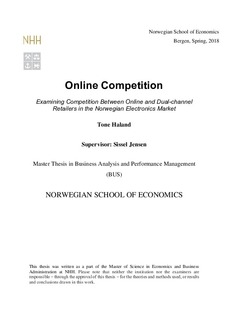Online competition : examining competition between online and dual-channel retailers in the Norwegian electronics market
Master thesis
Permanent lenke
http://hdl.handle.net/11250/2560466Utgivelsesdato
2018Metadata
Vis full innførselSamlinger
- Master Thesis [4372]
Sammendrag
The purpose of this thesis is to explore competition among retailers online. Online retailing
has grown significantly in recent years and is expected to keep growing. Simultaneously,
traditional brick-and-mortar retailers are experiencing less growth. Many traditional brickand-mortar
retailers have chosen to adapt by entering the online channel, becoming dualchannel
retailers. It is generally anticipated that the online channel is more competitive than
traditional brick-and-mortar retailing, due to lower search costs, technology and barriers to
entry. As dual-channel retailers operate in both markets, we wish to examine how this will
affect their prices. We test the hypothesis of online efficiency through looking at the price
levels and dispersion of online and dual-channel retailers.
We use a quantitative research methodology to examine whether online and dual-channel
retailers prices are different. Using price data from various retailers within the electronics
industry, we look at price levels and price dispersion to study competition between the retailer
types. The results show that the prices of online and dual-channel retailers are significantly
different. However, the results were the opposite of what we predicted, given the theory. We
found that dual-channel retailers have significantly lower prices and lower price dispersion
compared to online retailers. The results do not therefore support the existence of an online
disutility cost, or the notion of online channel efficiency.
